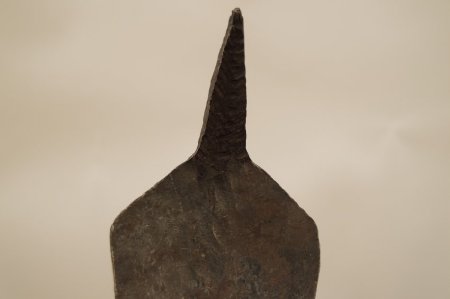Title:
Hoe Currency Blade
Object Name:
Blade, Hoe, Currency
Other Name:
Hoe, Wrought Iron
Place of Origin:
Loma (Toma), Liberia / Guinea, Africa
Provenance:
Aboriginal Indigenous Art.
L = 7—3/4"
Iron hoes have circulated as money in regions of India, Africa, and Indochina. Iron hoes were the smallest monetary unit in the Bahnars at one time. During the nineteenth century, iron, mainly in the shape of hoes, circulated in the remote areas of Sudan. The Chiga of western Uganda made hoes their unit of account without making use of them as a medium of exchange or store of value. In Portuguese East Africa a hoe standard replaced a cattle standard, and some hoes circulated only as currency and were never used as agricultural implements. In the French Congo, iron bars, shovels, hoes, blades, and iron double bells played the role of currency. In mid—nineteenth—century Nigeria, 40 iron hoes could buy a slave.
L = 7—3/4"
Iron hoes have circulated as money in regions of India, Africa, and Indochina. Iron hoes were the smallest monetary unit in the Bahnars at one time. During the nineteenth century, iron, mainly in the shape of hoes, circulated in the remote areas of Sudan. The Chiga of western Uganda made hoes their unit of account without making use of them as a medium of exchange or store of value. In Portuguese East Africa a hoe standard replaced a cattle standard, and some hoes circulated only as currency and were never used as agricultural implements. In the French Congo, iron bars, shovels, hoes, blades, and iron double bells played the role of currency. In mid—nineteenth—century Nigeria, 40 iron hoes could buy a slave.
Description:
Hoe shaped wrought iron. Oval—shaped at the bottom, coming to a tapering point at the top.
Collection:
Marianne Keown Collection
Material:
Wrought Iron
Used:
Domestic Use
Technique:
Blacksmithing
Owned:
Art Department, Missouri Southern State University
Accession#:
2015.3.15



